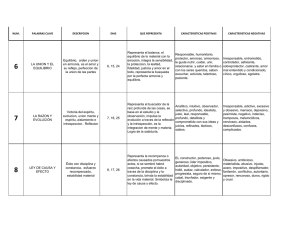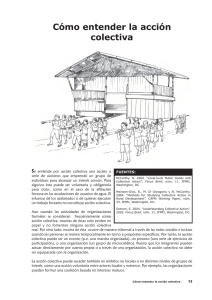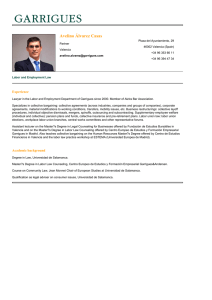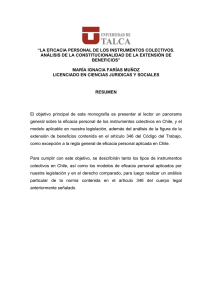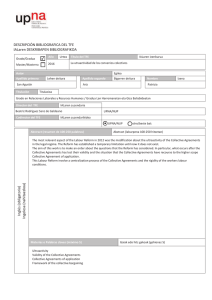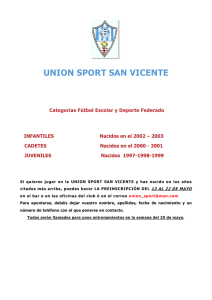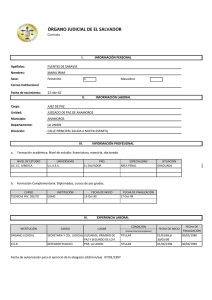guía docente abreviada de la asignatura
Anuncio
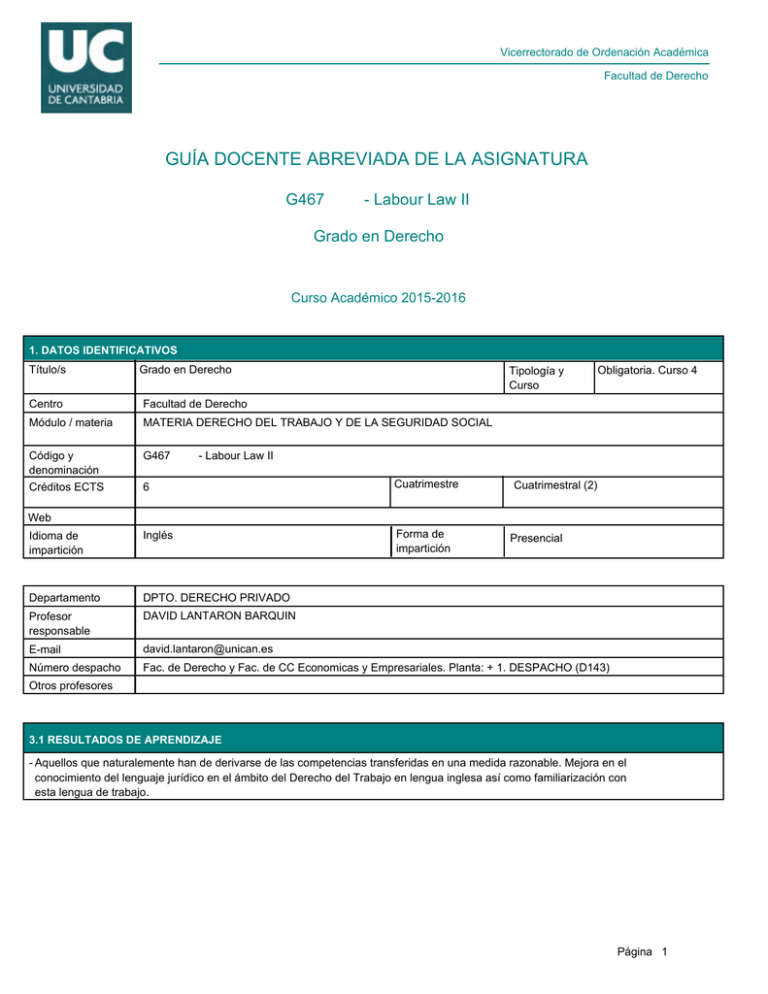
Vicerrectorado de Ordenación Académica Facultad de Derecho GUÍA DOCENTE ABREVIADA DE LA ASIGNATURA G467 - Labour Law II Grado en Derecho Curso Académico 2015-2016 1. DATOS IDENTIFICATIVOS Título/s Grado en Derecho Tipología y Curso Centro Facultad de Derecho Módulo / materia MATERIA DERECHO DEL TRABAJO Y DE LA SEGURIDAD SOCIAL Código y denominación Créditos ECTS G467 Obligatoria. Curso 4 - Labour Law II 6 Cuatrimestre Idioma de impartición Inglés Forma de impartición Departamento DPTO. DERECHO PRIVADO Profesor responsable DAVID LANTARON BARQUIN E-mail [email protected] Número despacho Fac. de Derecho y Fac. de CC Economicas y Empresariales. Planta: + 1. DESPACHO (D143) Cuatrimestral (2) Web Presencial Otros profesores 3.1 RESULTADOS DE APRENDIZAJE - Aquellos que naturalemente han de derivarse de las competencias transferidas en una medida razonable. Mejora en el conocimiento del lenguaje jurídico en el ámbito del Derecho del Trabajo en lengua inglesa así como familiarización con esta lengua de trabajo. Página 1 Vicerrectorado de Ordenación Académica Facultad de Derecho 4. OBJETIVOS El objetivo de la asignatura, amén de trasladar los rudimentos de nuestro Derecho Sindical en un entorno internacionalizador, radica en comprender el papel a desempeñar por los sujetos colectivos. Identidad de actores, mecanismos de garantía, competencias, el esencial papel de la negociación colectiva y otros mecanismos como la resolución de conflictos. Entender cuáles son sus dinámicas, interrelación y valor. Una visión de la libertad sindical amplia en un sentido moderno y puesto en relación con otras categorías del ordenamiento jurídico. Su impartición en lengua inglesa favorecerá la familiarización con el acervo conceptual básico de la materia en dicho idioma. Página 2 Vicerrectorado de Ordenación Académica Facultad de Derecho 6. ORGANIZACIÓN DOCENTE CONTENIDOS 1 UNIT 1 UNION AND CONSTITUTION: RIGHT OF UNION ASSOCIATION AND INSTITUTIONAL FUNCTIONALITY OF THE UNION 1. Unions´ constitutional approach: right of union association and unions´ institutional role. 2. Right of Union Association: legal entitlement 3. Right of Union Association content: a) Individual aspect, positive and negative dimensions. b) Collective aspect, freedoms of organisation and action. 4. Union legal regimen. Union liability. 5. Union representativeness: a) general statement; representativeness and greatest representativeness: requirements and responsibilities (powers). 6. Freedom of union association protection. Antiunion conducts. 7. Employers association: a) Constitutional role. b) Greatest representativeness. 8. A practical panorama of the public labour framework. 2 UNIT 2 ORGANISATION AND EMPLOYEES COLLECTIVE ACTION AT THE COMPANY 1. General approach. Models: dual-channel employees representation. 2. Unitary representation: Works councils and personnel delegates: a) Shaping. b) Competency power. c) Guarantees. d) Election. e) Inter-establishment council f) Joint works council 3. European Works Councils. Information and consultation employee rights in community-scale undertaking or group of undertakings. 4. Civil servants unitary representation. Personnel Delegates and Personnel Committee. 5. Workers specialised representation about risk prevention in the workplace. Safety officer. 6. Union representatives: a) Trade Union section: legal regime. b) Shop Stewards: election, competency power and guarantees. 7. Meeting (assembly) of workers. 3 UNIT 3 COLLECTIVE BARGAINING 1. Non-civil service and civil service employees collective bargaining. Agreements of professional interest (in relation with economically dependent self-employed). 2. General efficacy collective agreement: characterization, personal and juridical efficacies. 3. Collective bargaining unit and scope: a) functional and territorial scopes; b) collective agreements concurrence. 4. Negotiating parties: a) Firm (company) or inferior level agreements; b) Industry-wide (sectoral) agreements 5. Collective agreement content: a) scope and boundaries. b) contractual and normative content. 6. Processing. Collective agreement validity and publication. Labour Administration intervention. Ultra-activity. 7. Application, interpretation and judicial challenge of the collective agreement. 4 UNIT 4 INDUSTRIAL ACTION 1. Labour disputes: collective disputes. 2. The concept of collective dispute. 3. Industrial actions. 4. Means of settlement: non-judicial solution of conflicts. 5 UNIT 5 COLLECTIVE ACTION II: STRIKE AND LOCKOUT 1. Right to strike: a) conceptual approach and meaning b) Spanish legal regime. 2. Constitutional recognition and regulation. 3. Entitlement and exercise. The legal boundaries of the right to strike: illicit (abusive) and illegal strikes. Legal effects. Proceeding (procedure to follow). 4. Essential services and the right to strike. 5. Lockout: a) Concept and types. B) Constitutionality. c) Lawfull kinds of lockout. Página 3 Vicerrectorado de Ordenación Académica Facultad de Derecho 7. MÉTODOS DE LA EVALUACIÓN Descripción Tipología Eval. Final Recuper. Examen tipo test de quince preguntas con tres opciones. El aprobado precisará nueve respuestas acertadas. Examen escrito Sí Sí 60,00 Recensión crítica de lecturas técnicas en lengua inglesa sobre la materia. Se alternará con supuestos de aprendizaje basado en problemas Otros No No 30,00 Presencia y participación activa. Implicación personal en el aprendizaje, especialmete por cuanto concierne a las visitas institucionales y tutorización colectiva Otros No No 10,00 TOTAL % 100,00 Observaciones Observaciones para alumnos a tiempo parcial 8. BIBLIOGRAFÍA Y MATERIALES DIDÁCTICOS BÁSICA Manuales de Derecho del Trabajo que incluyan Derecho Sindical, siempre en su última edición. por la especial consideración a la lengua de publicación es una lectura recomendada: Gómez Abelleira, F.J., HANDBOOK OF SPANISH EMPLOYMENT LAW, Madrid (Tecnos), 2012 Esta misma singularidad de la lengua de impartición justifica recomendar, al menos, la consulta de la página web del Ministerio de Empleo y Seguridad Social en lengua inglesa. En particular la dirección correspondiente a legislación http://www.empleo.gob.es/en/sec_leyes/index.htm También se recomienda el manejo de algún diccionario "on line". Como mera opinión, pues indudablemente no es mi especialización, podría citarse wordreference.com http://www.wordreference.com/es/en/translation.asp?spen= Otros manuales de consulta recomendables son: GARCÍA-PERROTE ESCARTÍN, Derecho del Trabajo, Tirant Lo Blanch PALOMEQUE LÓPEZ, M y ALVAREZ DE LA ROSA, M. Derecho del Trabajo, CEURA. Mayores precisiones, se efectuaran en el aula. El constante cambio de la normativa laboral aconseja ser prudente en este espacio. Esta es la Guía Docente abreviada de la asignatura. Tienes también publicada en la Web la información más detallada de la asignatura en la Guía Docente Completa. Página 4
